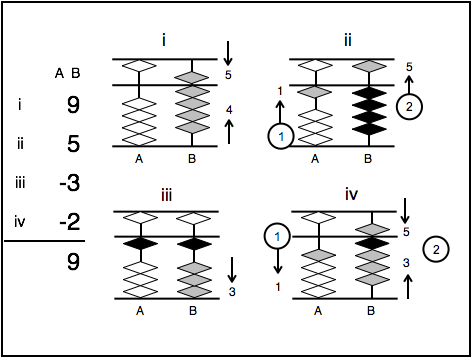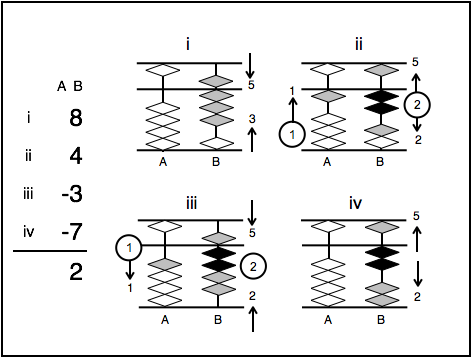Abacus Math Program – Lesson 8 – Ten Pair Complement Subtraction Part 2
Continuing from Lesson 7 Subtraction Part 1 we will look at a few more 10 pair complement subtraction examples. Again there are 5 possible 10 pair complements: 9-1, 8-2, 7-3, 6-4, 5-5. All of these pairs are reversible meaning we can use the complement pair, 9-1, for both the problem 10-1 just as we can use the same pair for the problem 10-9. So the following examples will look at some of the reverse pair possibilities such as subtracting -1, -2, -3, -4.
In the first example we start by adding 9 to the abacus. Next we add 5 to 9 but notice that we will need to use the 10 pair addition rule. So first add 1 to the next rod left, rod A, and then subtract 5, the 10 pair complement of 5, from 9 on rod B. The interim sum is now 14. Next subtract 3 from 4 on rod B for an interim sum of 11. Lastly subtract 2 from 11 by subtracting 2 from 1 on rod B. But since there are not enough beads touching the reckoning bar we will need to use the 10 pair subtraction rule. So first subtract 1 from the next rod left, rod A, and then add 8, the 10 pair complement of 2, to 1 on rod B for a final answer of 9.

In the next example we start by adding 8 to the abacus. Next we add 4 to 8 using the 10 pair addition rule. So first add 1 to the next rod left, rod A, and then subtract 6, the 10 pair complement of 4, from 8 on rod B. The interim sum is now 12. Next subtract 3 from 12 by subtracting 3 from 2 on rod B. Again we will need to use the 10 pair subtraction rule. First subtract 1 from the next rod left, rod A, and then add 7, the 10 pair complement of 3, to 2 on rod B. The interim sum is now 9. Finally subtract 7 from 9 on rod B for a final answer of 2.

In the last example we start by adding 6 to the abacus. Next add 4 to 6 using the 10 pair addition rule. So first add 1 to the next rod left, rod A, and then subtract 6, the 10 pair complement of 4, from 6 on rod B. The interim sum is now 10. Next subtract 1 from 10 by subtracting 1 from 0 on rod B. Again we will need to use the 10 pair subtraction rule. First subtract 1 from 1 on the next rod left, rod A, and add 9, the 10 pair complement of 1, to 0 on rod B. The interim sum is now 9. Lastly add 8 to 9 on rod B by using the 10 pair addition rule. First add 1 to 0 on next rod left, rod A, and subtract 2, the 10 pair complement of 8, from 9 on rod B. The final answer is 17.

Next up Lesson 9 introducing the 5 Pair.

Leave a Reply